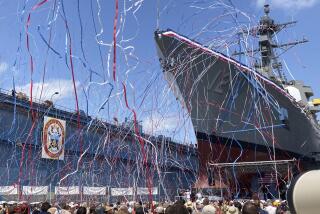A Quiet Salute to a Mighty Warship : Navy: The New Jersey arrives in Long Beach to be readied for mothballing. It is one of only four U.S. battleships and is the fleet’s most decorated vessel.
- Share via
Without fanfare, the battleship New Jersey, the Navy’s most decorated ship, sailed into the Long Beach Naval Station on Friday, the last time it would steam under its own power before being decommissioned and placed into the nation’s mothballed fleet.
No bands played, no military or civilian officials saluted as the aged battlewagon steamed in at noon into Pier 6.
“This is just another day in the life of the battleship,” the New Jersey’s skipper, Capt. Ronald D. Tucker, said.
But the New Jersey, bristling with awesome armament ranging from its powerful 16-inch guns to its Tomahawk and Harpoon cruise missiles, is not just another battleship. The vessel has played a major role in America’s military history and was one of only four battleships remaining in the Navy’s fleet.
Its last journey Friday was a brief one, sailing into the Navy facility on Terminal Island from Seal Beach, where it had unloaded its considerable ammunition. The New Jersey’s crew of 1,500 enlisted men and 75 officers are being reassigned because the ship--which costs approximately $37 million a year to maintain--is a victim of cuts in defense spending during a new era of detente among the major powers.
Tucker, 48, of Santa Monica, made it clear that he understands times have changed. But he nevertheless declared that dreadnoughts like the New Jersey still can make a big diplomatic impact in the world’s trouble spots.
“There’s no better ship to send as an instrument of diplomacy. It’s awesome. It bristles. This is a compelling ship,” he said.
Launched by the Philadelphia Naval Shipyard a year to the day after the bombing of Pearl Harbor, the New Jersey was commissioned on May 23, 1943, as the second battleship of the Iowa class--the fastest, most heavily armed of the U.S. battleships.
By the time the war was over, the New Jersey had become the flagship for two admirals--William Frederick (Bull) Halsey and Raymond A. Spruance. Its 1944 and 1945 record, displayed on its bridge wing in a row of ribbons longer than on any other Navy ship, reads like a history of World War II’s Pacific Theater.
Its operations included the Marshall Islands, New Guinea, the Marianas, the Western Caroline Islands, Leyte, Luzon, Iwo Jima and Okinawa. And yet, according to Navy historians, not one sailor stationed aboard the New Jersey was killed during those monumental battles.
“It was in all the major battles,” said a Long Beach public affairs officer, Lt. Cmdr. Steven B. Chesser, who served 2 1/2 years aboard the New Jersey. “I’m very sad to see it go. It’s part of my life.”
The United States, Chesser said, is the only naval power left in the world that maintains battleships. The three left are the Iowa, Missouri and the Wisconsin--all World War II-vintage vessels. That they don’t make them like the New Jersey anymore is evident in more than its firepower. About 57,000 square feet of teak decking--in contrast to steel decking used in the Navy’s modern-day ships--has been rubbed almost white in spots by thousands of hours of swabbing by the New Jersey’s seamen.
Since World War II, the New Jersey has been mothballed and recommissioned four times, seeing action in both the Korean and Vietnam conflicts.
Recommissioned for the last time on Dec. 28, 1982, the New Jersey raked Syrian anti-aircraft batteries in the mountains overlooking Beirut in December, 1983. The action was controversial and some critics charged that Lebanese civilians suffered more than the Syrian personnel.
“It was intense,” said Boatswain’s Mate 2nd Class Nathaniel Kinard, 27, of Chicago, recalling the shelling. “I didn’t find out about the criticism until we got back.”
On Friday, the crew began the arduous task of readying the 887-foot-long battleship for the mothball fleet off Bremerton, Wash., where it will be towed next March after its scheduled decommission date in early February.
Cmdr. Chris Martin, the battleship’s operations officer supervising the decommissioning process, found irony in his final duty. He was supervisor when the Iowa was brought out of dry dock in Philadelphia in 1983.
“Now,” said Martin, “I’ve gone full circle.”
More to Read
Sign up for Essential California
The most important California stories and recommendations in your inbox every morning.
You may occasionally receive promotional content from the Los Angeles Times.









